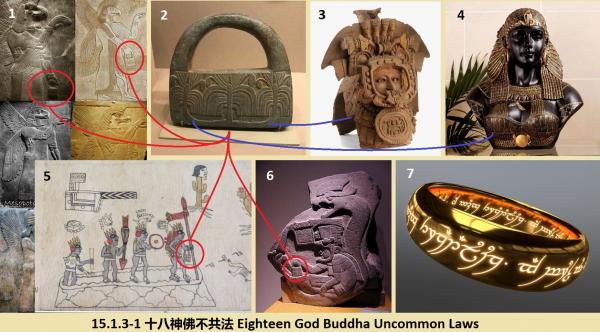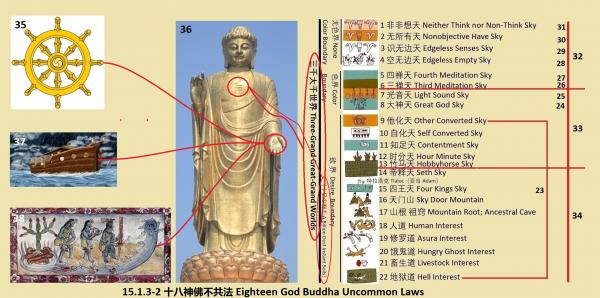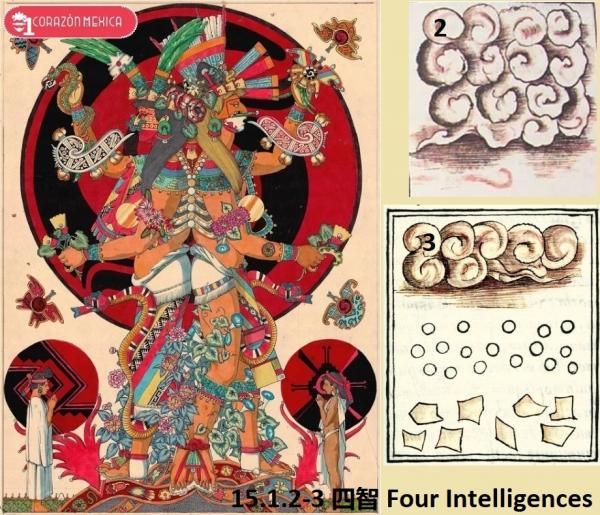此十八法是神佛自我約束的戒律,只適用於八地至十地的摩訶薩(即大菩薩),不與其它眾生共享,故稱不共法,是戒藏的一部分。佛教用桫欏樹(一種棕櫚樹,如圖15.1.3-1-2所示)和戒指(如圖7)來象徵戒法。戒指象徵着菩提心戒(參見16.1節),就是入學大乘佛教時所立下的誓言。此誓言又名願渡,可以統攝一切戒法。戒藏包括三枝(如圖2),一枝是男戒,名為三千威儀八萬四千細行,又名黃金甲(如圖3所示,身着黃金甲的特拉洛克,亞當),一枝是女戒,名為五百威儀十萬八千魅力,又名女人皮(如圖4所示,埃及夏娃身着黃金甲),中間的一枝就是這十八神佛不共法。如圖1所示世界的許多地方發現了那種浮雕或雕像,但本書說約在公元1325年,墨西哥(即一位特拉洛克,亞當)再一次從地獄裡取回了戒藏,如圖5和6(參見第18章《太陽石》)。 These 18 laws are the self-restraint precepts of Gods, Goddesses, and Buddhas. They are only applicable to Mahasattvas (that is, great Bodhisattvas) from the eighth land to the tenth land, do not common with other sentient beings, so they are called Non-Common Laws, which is a section of The Covenant Ark (see fig. 15.1.3-1-2). Buddhism uses the Sal Fasullo tree (a kind of palm tree, Figure 2) and a ring (Figure 7) to symbolize the precepts. The ring symbolizes the “Bodhisattva’s Oath” (see Section 16.1), which is the vow taken when enrolling in Mahayana Buddhism. This oath, also known as Ark of Will, can assimilate all precepts. The Covenant Ark includes three branches (as shown in Fig. 2). One is Man Precepts, namely 3,000 Majesties 84,000 Enchantments, also known as Golden Armor (as shown in Figure 3, Tlaloc, Adam wearing golden armor), one branch is Woman Precepts, namely 500 Majesties 108,000 Charms, also known as Woman’s Skins ((as shown in Figure 4, Egyptian Eve is wearing golden armor), and the middle branch is the Eighteen God Buddha Uncommon Laws. Reliefs like the one shown in Figure 1 have been found in many parts of the world, but this book says that about 1325 AD, Mexico (he is an Adam, a Tlaloc) retrieved the Covenant Ark again from hell, as shown in Figures 5 and 6 (see Chapter 18, "The Sun Stone" 》). 
(一)身無失,佛自無始劫以來,持戒清淨,行住坐臥具足三千威儀八萬四千細行,由此功德圓滿故,一切煩惱不打攪,雜染劣種出盡,故於身無失。 (01) Body without Fault, since the no beginning of catastrophes, Buddha has held the immaculate precepts, walking, standing, sitting, and lying, all are fully with 3,000 Majesties 84,000 Enchantments, because of this fulfilled fortune and virtue, all annoyances do not bother him, all contaminated inferior seeds have been ousted, therefore body without fault. (二)口無失,佛已修滿三大阿僧脂劫,具足親身經驗,於無為法和有為解脫法理論醇熟,故於大眾中說法,以清淨法眼洞察機緣,慧眼裂解結症,有的放矢,言簡意賅,隨口而言,沒有錯誤,使聞言者皆依自根力而有所證悟。 (02) Mouth without Fault, Buddha has completed the cultivation of Three A-Monk-Index Catastrophes, and is well versed in the theories of None-As Laws (see section 11.6.4 Off-is Fruit) and Have-As liberation laws, so he speaks to the public, with his immaculate juristic eye to see mind mechanical influencing factors, with his gnostic eye to explicitly analyses entangled symptoms, with clear purpose and succinct concise language, speak as he pleases without making mistakes, so that those who hear the words all will realize something according to their own root’s strengths. (三)念無失,佛的念力深厚,於大眾中說法,若有插問或反駁,心不散亂,佛無所畏懼地回答插問,駁斥悖論。轉回來,佛就繼續講,不會失念,沒有停住了反問,“我們剛才討論什麼來着?我講到哪了?” 沒有這事。 (03) Spells without Loss, Buddha's spell-power is strong, when he speaks in the midst of congregation if there are interjections or rebuttals. his heart does not disperse, answers without fear. Turning back, Buddha continues to speak from what he left, without losing his spell, without stopping to ask rhetorically, "What were we discussing a moment ago? What are I just said? " There is no such thing. (四)無歧視,佛已證得平等性智,於大眾中說法,平等普渡,心無揀擇,不會厚此薄彼。 4) Non-Discrimination, Buddha having testified and gained the Equal-Nature Intelligence, preaching in the midst of congregation, equally transcendingly ferry all sentient beings, heart without pick, wouldn’t favour this acerbate that.

插圖15.1.3-2-36是釋迦摩尼的塑像。他胸前的卍字義為吉祥和十億,象徵着三千大千世界,和雷音,因為名譽上雷音創造了三千大千世界,亞當(即睚眥、金童),和夏娃(即磨牙、玉女),並且宣布上帝的全部教法和財產是屬於全人類和眾生的共法和共產。那這18不共法怎麼說?這十八神佛不共法也是共法,歡迎任何人來加入上帝、亞當、和夏娃,一起拯救世界;標註為不共法是要提醒讀者,任何人要共享此法,應當先徹底懂得此法。釋迦摩尼手中法輪是佛教的標誌(如圖35),是般若舟(如圖37、38)的舵盤。 Illustration 15.1.3-2-36 is a statue of Shakyamuni. The swastika on his chest means auspiciousness, and a billion, symbolizing the Three-Grand Great-Grand Worlds, because famously Thor created the Three-Grand Great-Grand Worlds, Adam (i.e. Tanngnjóstr, gold boy), and Eve (i.e. Tanngrisnir, jade girl), and declared that all God's teachings and properties are Common Laws and Commonwealths, belong to all mankind and all sentient beings equally. What about the 18 Uncommon Laws? These 18 Uncommon Laws of God and Buddha are also Common Laws, and anyone is welcome to join God, Adam, and Eve in saving the world; the labeled Uncommon Laws are meant to remind the reader that anyone who wants to share in this Law should first thoroughly understand it. The Juristic Wheel (see fig 35) in the hand of Shakyamuni is a symbol of Buddhism and the steering wheels of Arks (see fig. 37, 38). (五)無不定心,佛於行住坐臥,或於眾中說法時,悉皆具足三千威儀,心常不離甚深勝定(參見16.3節《發光地》)。 5) No Non-Still Heart, when Buddha is walking, standing, sitting, and lying, or when he is preaching in the congregation, all are fully equipped with the 3,000 Majesties 84,000 Enchantments, and his heart is always in very deep Victorious Stillness (cf. section 16.3 Glory Land). (六)無不知而舍,無知而不舍。這是亞當的一個特質(如圖15.1.3-3,參見10.9節),他這個人對自己不懂的事物都能記住,學明白之後就忘了,所以亞當是個愚魯之人,有點兒傻。根據亞當的這個特質,神父(即上帝)從他幼時開始就總是在他的生活中做惑。亞當把上帝對他所做的怪事都記住了,以至於積累了太多的迷惑,就墮入地獄了(即患了覺思失調症)。在地獄裡,亞當面對死亡,悲傷不已,總是不停地想。人的記憶是和情感儲存在一起的,偶然地亞當就回憶出了神父在他三歲以前告訴過他:“你是我的教子,我會把女兒夏娃許配給你,並讓你繼承我的王位!”亞當就興奮了,去找夏娃結婚,並且繼承她父親的王位。讀者可能感覺奇怪,怎麼上帝會讓一個傻子來繼承自己的王位呢!?夏娃不傻呀!而且她知道她父親對亞當做了什麼,她聽了亞當的故事,就信了,覺悟了,成為真人了,而且成為了世界第一。這就是上帝造人的主題線索,即是插圖16.1.3-2-15右邊的那根線的意義。具體上帝造人的故事參見第18章《太陽石》。最終亞當怎麼樣了?由於他幼時的創傷和地獄的折磨,他總是不停地思考,是永遠的佛。佛源自巴利語,覺義。 6) No unknown is abandoned; no having-known is not abandoned. This is a trait of Adam (as in Figure 15.1.3-3, cf. Section 10.9). He always remembers things that he does not understand and forget them after learning them, so, Adam is a dumb, a moron. According to this trait of Adam, godfather (i.e. God) had always been causing confusion in his life since his childhood. Adam remembered all the strange affairs God had done to him, so many muddles accumulated that he fell into hell (i.e. fell into Schizophrenia). In hell, Adam faced death, grieved, and kept thinking about his own life. Human memory is stored together with emotions. By chance, Adam recalled that his godfather told him before he was three years old: "You are my godson. I will betroth my daughter Eve to you and let you inherit my throne." Adam got excited and went to marry Eve and to inherit her father's throne. Readers may wonder why God allowed a fool to inherit his throne!? Eve is not stupid! And she knew what her father had done to him. After listening to Adam's stories, she believed him, enlightened, became a real human, an invincible, and world No.1. This is the theme line of God’s creation of man, which is the meaning of the line on the right side of Illustration 16.1.3-2-15. For the specific story of God’s creation of man, see Chapter 18 “The Sun Stone”. What happened to Adam in the end? Due to his childhood trauma and the torture of hell, he always kept thinking, is a permanent Buddha. Buddha is a Pali word, means Perception.

(七)欲無減,佛具足四無量心,具有無窮的力量,由是佛常欲度諸眾生,心無厭足。四無量心是慈悲喜舍。慈,常懷慈心,對眾生的煩惱苦處感通身受。悲,常懷悲心,對眾生受到生老病死魔的傷害,深感悲傷。喜,常懷隨喜心,對眾生的歡笑喜慶,佛與眾同樂。舍,常懷舍心,舍性是平等之心,佛常懷平等待人之心。 7) Desires without Decrement, Buddha is fully with the four infinite hearts, has inexhaustible strength, thus, he always desires to transcendentally ferry sentient beings, unsatiable. The four infinite hearts are mercifulness, sorrowfulness, delight, and renunciation. Mercifulness, constantly bosoming a merciful heart, is empathetic to the annoyance and bitter of sentient beings like the body is accepting. Sorrowfulness, constantly bosoming a sorrowful heart, is deeply saddened by that sentient beings are harmed by the demons of birth, old age, sickness, and death. Delight, always bosoming a heart of following delight, to sentient beings’ joys and celebrations, Buddha joins the crowds to laugh along. Renunciation, always with a heart of renunciation, the nature of renunciation is the heart of equality, Buddha always bosoms the heart of treating people equally. (八)精進無減,佛自覺覺它,教學相長,如是佛常精進,普渡眾生,盡未來際。 8) Diligently Advancement without Decrement, Buddha self-enlightens and enlightens others, teaching and studying are mutually beneficial, thus, he or she constantly diligently advances to the exhaustion of future. (九)慧無減,佛已經掌握了上帝的心理機制學,以至圓融,具有了一切慧。又在普渡眾生中千錘百鍊,愈發精銳,如是佛于慧隨機而說,不會減少,更沒有盡。 9) Gnosis without Decrement, gnosis is heart of interpreting know, is the Three-Grand Great-Grand Worlds (as shown in fig. 15.1.3.2-1 to 34). Buddha has mastered the Mind Mechanism of God to roundly perfection and possesses all gnosis. And he or she has been refining it during broadly transcendental ferry of sentient beings, has become more and more essentially keen, thus, Buddha expediently preaches gnosis, neither decrement nor exhaustion. (十)念無減,佛採用並修成了上帝的心理機制學,以四無礙解(參見16.9節)總持一切佛法,如是,佛對佛法的所有理論和能解決的現實問題瞭然於胸,隨意起念,以念持心,身口意業隨念而來,不會丟失或減少。 10) Spell without Decrement, Buddha has adopted and reshaped the godly mind mechanics, by the Four Non-Hindrance Interpretations (cf. section 16.9) to generally hold all laws, thus, he or she lucidly bosoms all Buddhist principles and muddles to solve, arouse spell at will, by spell holds heart, bodily orally and intentionally karmas answer to spell to come, neither loss nor decrement. (十一)解脫無減,佛已經證得了有為解脫、無為解脫、和無住涅槃,又在普渡眾生中反覆實踐,如是佛的解脫已至於無縛無解。 11) Liberation without Decrement, Buddha has testified and gained have-as liberation, none-as liberation, and Non-Dwell Nirvana, and has actually applied those repeatedly during broadly transcendingly ferry sentient crowds, thus, his or her emancipation has reached no bondage no liberation. (十二)解脫知見無減,佛建設起了佛法的架構體系,如生命之樹,四勝諦,五眼通(參見第17章,和第18章的五個太陽)等,也對人生的全部追求、煩惱和對治方法做了編碼和列表,如是,佛能夠提綱挈領,開合自如地講解滅苦得樂之道,沒有遺漏和缺失,能夠維持解脫知見明了。 12) Emancipative Know and View without Decrement, Buddha has systematically established juristic frames, such as Tree of Life, Four Victorious Cruxes, Five Eyes Through (cf. chapter 17 and the Five Suns in chapter 18), etc. and has numbered tabulated all the life pursuits, annoyances, and remedies. Thus, he or she with the outlines in hand can fold and unfold the paths of terminating bitter gaining laughs at will, no omissions, can maintain lucid interpretations of liberation. (十三)一切身業隨智慧行,佛的身業以智為導首,隨念而行,示現各種殊勝形相,師範於眾。 (十四)一切語業隨智慧行,佛的語業以智為導首,微妙清淨語言隨智慧而轉,口吐蓮花,饒益有情。 (十五)一切意業隨智慧行,佛的意業以智為導首,隨智而轉,入眾生心而為說法,除滅痴惑無明黑暗。 13) All bodily karmas follow intelligence and gnosis to behave. Buddha’s bodily karmas are by intelligence as leader, along spells to present, manifesting all kinds of extraordinary forms to exemplify for crowds. 14) All orally karmas follow intelligence and gnosis to behave. Buddha’s oral karmas by intelligence as leader, subtly wonderful language along intelligence and gnosis to present, mouth spits out lotus flowers, prosperously benefit sentient beings. 15) All intentionally karmas follow intelligence and gnosis to behave. Buddha’s intentional karmas are by intelligence as leader, turn along intelligence, enter sentients’ hearts to preach, remove and terminate foolish muddles, non-light (i.e. ignorance) darkness. (十六)智慧知過去世無礙,佛的智慧照知過去世所有一切,若有情法,若無情法,皆無障礙。 (十七)智慧知現在世無礙,佛的智慧照知現在世所有一切,若有情法,若無情法,皆無障礙。 (十八)智慧知未來世無礙,佛的智慧照知未來世所有一切,若有情法,若無情法,皆無障礙。 16) Intelligence and gnosis know the past without hindrance. By intelligence and gnosis, Buddha lucidly knows all things in the past worlds such as sentients, such as non-sentients, there all are no hindrances. 17) Intelligence and gnosis know the present without hindrance. By intelligence and gnosis, Buddha lucidly knows all things in the present worlds, such as sentients, such as non-sentients, there all are no hindrances. 18) Intelligence and gnosis Know the future without hindrance. By intelligence and gnosis, Buddha lucidly knows all things in the future worlds, such as sentients, such as non-sentients, there all are no hindrances. ↪️返回第15章《滅諦》的目錄↪️Back to Catalog of Chapter 15 Salvation Crux
|
